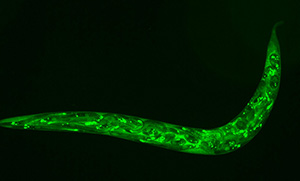Worm model reveals gene causing neuronal programming
The Pocock Group at BRIC, University of Copenhagen, is digging deep into the mechanisms behind the generation of neurons. More specifically, they are using the roundworm C. elegans as a model to identify novel mechanisms that control neuronal programming. By identifying mutant worms that have defects in the specification of oxygen and carbon dioxide sensing neurons, they found that in four isolated cases, the specification defect was caused by mutations in a conserved molecule called EGL-13. The results have just been published in the international journal PLOS Genetics.
EGL-13 mutants misbehave
EGL-13 determines whether a neuron develops the ability to sense changes in oxygen and carbon dioxide levels. The Pocock Group examined why a neuron in some cases does not react as expected. They found that EGL-13 mutant worms are unable to generate an appropriate neuronal response to changes in either oxygen or carbon dioxide in their  environment. This means that the worm is not able to process the appropriate information on oxygen or carbon dioxide levels and that worms lacking EGL-13 cannot mount a behavioural response to such changes, which could lead to death in the wild. In human beings, it would mean that our brains are not able to sense if our carbon dioxide levels are too high and would result in an inability to breathe in response to changes in this toxic gas. This deficit in fact occurs in some disorders such as Sudden Infant Death Syndrome (SIDS).
environment. This means that the worm is not able to process the appropriate information on oxygen or carbon dioxide levels and that worms lacking EGL-13 cannot mount a behavioural response to such changes, which could lead to death in the wild. In human beings, it would mean that our brains are not able to sense if our carbon dioxide levels are too high and would result in an inability to breathe in response to changes in this toxic gas. This deficit in fact occurs in some disorders such as Sudden Infant Death Syndrome (SIDS).
EGL-13 - more than a lifesaver
The new research from the Pocock Group shows that EGL-13 not only controls the expression of genes that afford oxygen and carbon dioxide sensing neurons with their molecular identity.
”Our research shows that the egl-13 gene is essential for genes involved in oxygen and carbon dioxide sensing to be appropriately expressed. In other words, EGL-13 is a molecular switch, turning on an entire battery of genes involved in the specialization of neurons,” says PhD student Jakob Petersen who has led the experimental investigation.
Furthermore, the findings indicate relevance for other neurodevelopmental mechanisms. Group Leader for the team behind the results and Associate Professor Roger Pocock expresses,
“All the factors we described to regulate oxygen and carbon dioxide sensing neuron specification are conserved in higher organisms. Therefore, we propose that the mechanisms we have discovered are relevant to specification of oxygen and carbon dioxide sensing neurons is also relevant in humans.”
By gaining knowledge of how terminal differentiation of these specific neurons is established, the research group hope to provide important information that may be used for programming specific neurons in cell culture systems and thereby for possible therapeutic avenues. This work was made possible by generous support from the Lundbeck Foundation.
Related News
Contact
 Associate professor
Associate professor
Roger Pocock
roger.pocock@bric.ku.dk
Phone: +45 353-25761
 PhD student
PhD student
Jakob Gramstrup Petersen
jakob.petersen@bric.ku.dk
Phone: +45 353-25530
